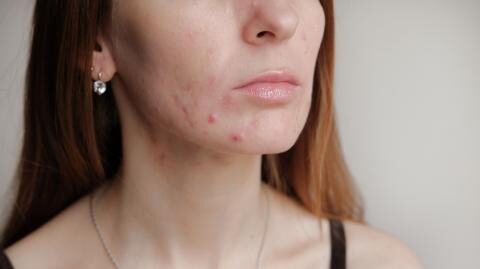Following a bout of confidence-destroying inflammatory acne, many of us are cursed to deal withstubborn pigmentation that can take months to years to fade out. This pigmentation can be separated into three categories, post-inflammatory hypopigmentation, post-inflammatory erythema (PIE) and post-inflammatory hyperpigmentation (PIH), the latter of which being the most common.
Discover our latest podcast
What is post-inflammatory hyperpigmentation?
PIH is a skin condition that can affect all skin types and ages but is more prevalent in people with darker skin tones. If you have PIH, you’ll notice that some small patches spots on your skin are darker and don’t match your overall skin tone.
What causes post-inflammatory hyperpigmentation?
PIH occurs when there is a wound or trauma to the skin, like a pimple, triggering an inflammatory response. This inflammation sends a signal to the melanocytes, which produces an increased amount of melanin in the affected area. Many skin traumas can trigger PIH, such as UV damage, acne breakouts, harsh chemicals on the skin, and even hormones.
How to beat post-inflammatory hyperpigmentation
This type of inflammation isn’t permanent and often fades within the space of months to years, and if time isn’t doing quite cutting it, there are many over the counter (OTC) and dermatologist treatments for PIH.
Topical products for PIH
Topical products to treat PIH are often available both in OTC products or by prescription. Often the prescription treatments are of a higher concentration and should be used incrementally or by the advice of a healthcare professional.
Hydroquinone
Hydroquinone is a common skin lightening agent which can help to reduce the appearance of PIH. This topical product is available OTC in some countries, but others may require a prescription from a doctor or dermatologist.
Depending on the product’s strength, hydroquinone can be rather irritating to the skin, so dry and sensitive skin types may want to start on a lower percentage or sandwich the product between layers of moisturiser.
Retinol
OTC retinol is famous for its anti-ageing benefits, but it can also help eliminate PIH. Retinol helps reduce post-inflammatory hyperpigmentation by promoting skin cell turnover, creating new and more evenly pigmented skin cells.
OTC retinol often comes in low percentages and takes about six months of consistent application to take effect. However, if you find you just can’t wait that long, more potent prescription retinoids such as adapalene and tretinoin complete the same task at a faster rate.
Azelaic acid
Azelaic acid is both available OTC and by prescription and is often used as a topical treatment for acne and rosacea. However, small studies have shown that azelaic acid can also act as a low-risk treatment for PIH. This is because azelaic acid has tyrosinase inhibiting properties, working against the enzyme that supports melanin production.
Vitamin C
Vitamin C or ascorbic acid is an easy to find OTC product that helps decrease melatonin production and fade existing dark spots. This common skincare ingredient also has antioxidant and anti-inflammatory properties that fight off both hyperpigmentation caused by sun damage and PIH.
For better results, vitamin C is also great to use in combination with other PIH treatments such as azelaic acid and retinoids.
Niacinamide
Niacinamide, also known as nicotinamide, is a water-soluble form of vitamin B3 with a vast range of benefits for the skin, including reducing sebum production, PIE, rosacea and can even treat PIH.
In vitro studies have shown that niacinamide reduces PIH by preventing the transfer of melanosomes from melanocytes to keratinocytes, meaning it helps prevent pigments from leaking into the skin cell.
Other studies have shown that when used in concentrations of about 4-5%, niacinamide could help to reduce hyperpigmentation from both UV damage and skin trauma. In fact, niacinamide at 4% was found to be just as effective as hydroquinone at the same concentration.
Chemical exfoliants
Chemical exfoliants, more specifically alpha hydroxy acids, are also great at helping reduce PIH. AHAs such as lactic or glycolic acid help promote skin cell turnover, resulting in a newer and more evenly toned layer of skin.
SPF
Perhaps the most essential ingredient when it comes to repairing and preventing PIH is SPF. Sun exposure can cause both UVA and UVB damage which will only further provoke pigmentation. Not to mention, many treatments that treat PIH, such as retinol and hydroquinone, are sun sensitising, meaning when exposed to the sun, they can cause skin irritation.
When exposed to the sun, SPF should be applied every two hours. If you need some help incorporating SPF into your skincare routine, check out our complete guide to SPF here.
Dermatologist treatments
PIH is one of the leading issues that prompt people to seek dermatologist treatment. However, physical treatments shouldn’t be the first line of defence against PIH as they run the chance of irritating the skin and further provoking hyperpigmentation.
Chemical peels
If topical treatments aren’t working to get rid of your PIH, a dermatologist may suggest a chemical peel instead. This treatment breaks the bonds holding the first two layers of skin together, causing the skin’s surface to peel off and promotes the generation of collagen and new skin cells. Chemical peels often use the same ingredients as chemical exfoliants but in much higher concentrations.
Chemical peels for PIH are usually a one-off treatment, but they can cause the skin to become very sensitive, making it prone to sunburns and inflammation. If the wrong ingredients are used or in the wrong concentration, this treatment could even cause more pigmentation.
Laser therapy
Laser therapy is also occasionally used for PIH. This treatment uses lasers to break up the pigmentation in the skin. However, more studies are needed to determine the efficacy and side effects of lasers on PIH.















